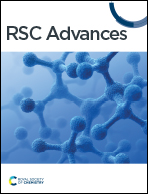
RSC Advances
Subject area
Water articles published in the last
6 months

Effective separation of dyes/salts by sulfonated covalent organic framework membranes based on phenolamine network conditioning
This study developed a modified polyacrylonitrile (PAN) membrane controlled by a phenol–amine network and enhanced with a sulfonated covalent organic framework (SCOF), aimed at improving the efficiency of textile wastewater treatment.

RSC Adv., 2024,14, 14593-14605
https://doi.org/10.1039/D4RA01736F
Advanced photocatalytic materials based degradation of micropollutants and their use in hydrogen production – a review
The future directions of photocatalytic degradation of micropollutants (pharmaceuticals, dyes, pesticides, etc.) and its role in green fuel production from wastewater are discussed with several examples of modern photocatalysts.

RSC Adv., 2024,14, 14392-14424
https://doi.org/10.1039/D4RA01307G
Enhanced thermal desorption of chlorinated hydrocarbons by nanoscale zero-valent iron: the effect of in situ dechlorination
The thermal desorption of CHs in contaminated soil was enhanced by the in situ dechlorination effect brought by the addition of nZVI.

RSC Adv., 2024,14, 14254-14262
https://doi.org/10.1039/D4RA01077A
Mechanistic explanation and influence of molecular structure on chemical degradation and toxicity reduction by hydroxyl radicals
The study elucidated environmental toxicity impact along with mechanistic degradation of organic emerging contaminants with different aromaticity and aliphaticity.

RSC Adv., 2024,14, 13926-13933
https://doi.org/10.1039/D4RA00827H
Degradation of fluoride in groundwater by electrochemical fixed bed system with bauxite: performance and synergistic catalytic mechanism
This study demonstrates that the coordinated defluorination system (IE-BA) which is made up of the industrial aluminum electrode and natural bauxite for fluoride removal. The defluorination mechanism of the IE-BA system is discussed.

RSC Adv., 2024,14, 13711-13718
https://doi.org/10.1039/D4RA01359J
Application of cold-adapted microbial agents in soil contaminate remediation: biodegradation mechanisms, case studies, and safety assessments
Analyzed the microorganisms cold-adapted mechanism, and summarized the degradation pathway of nitro-aromatic compounds. Evaluated safety of microbial agents according to the existing application restoration cases under freeze-thaw cycles condition.

RSC Adv., 2024,14, 12720-12734
https://doi.org/10.1039/D4RA01510J
Resistance and durability of fly ash based geopolymer for heavy metal immobilization: properties and mechanism
This study employed geopolymerization technique to solidify MSWI fly ash, aiming to facilitate its reutilization. The FA based geopolymers exhibit strong durability and mechanical qualities, making them suitable for a variety of applications.

RSC Adv., 2024,14, 12580-12592
https://doi.org/10.1039/D4RA00617H
Reusable magnetic mixture of CuFe2O4–Fe2O3 and TiO2 for photocatalytic degradation of pesticides in water
Mixture of TiO2-P25 and magnetic CuFe2O4–Fe2O3 nanocomposites improves photocatalytic water treatment and enables easy catalyst recovery, effectively degrading pollutants like 2,4-D.

RSC Adv., 2024,14, 12337-12348
https://doi.org/10.1039/D4RA00094C
Freezing-enhanced chlorination of organic pollutants for water treatment
Freezing-accelerated chlorination was observed for different organic pollutants and the chlorine/freezing system shows potential feasibility for water treatment in cold environments.

RSC Adv., 2024,14, 12218-12224
https://doi.org/10.1039/D4RA00081A
Optimization of isotropic MoS2/PES membranes for efficient treatment of industrial oily wastewater
Elimination of tiny oil droplets nearly miscible with wastewater can be realized using membrane technology through ultrafiltration.

RSC Adv., 2024,14, 12058-12070
https://doi.org/10.1039/D4RA01052C
The engineering of defect-modified boron nitride ribbons: an effective adsorbent to rapid capture for tetracycline
BN-3 with 33% N defects has the biggest adsorption rate and the adsorption capacity of 302.15 mg g−1 for TC due to the decreased the absorption energy and the dominated chemisorption.
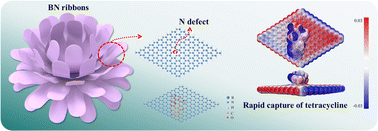
RSC Adv., 2024,14, 11932-11938
https://doi.org/10.1039/D4RA01941E
Novel ultrasonic technology for advanced oxidation processes of water treatment
Textile wastewater accounts for a significant proportion of industrial wastewater worldwide.

RSC Adv., 2024,14, 11939-11948
https://doi.org/10.1039/D4RA01665C
Corals-inspired magnetic absorbents for fast and efficient removal of microplastics in various water sources
Mesoporous Fe3O4 nanoparticles were coated with polymerized dopamine to mimic corals for adsorption of microplastics from different water sources.

RSC Adv., 2024,14, 11908-11913
https://doi.org/10.1039/D4RA02521K
Enhanced reduction of COD in water associated with natural gas production using iron-based nanoparticles
The industrial wastewater produced in the natural gas industry contains many organic and inorganic pollutants which prohibits its reuse. This study demonstrates an effective method for reducing the COD (chemical oxygen demand) content in formation water using iron-based nanoparticles.

RSC Adv., 2024,14, 11633-11642
https://doi.org/10.1039/D4RA00888J
Comprehensive assessment of carbon-, biomaterial- and inorganic-based adsorbents for the removal of the most hazardous heavy metal ions from wastewater
This article is about recoverable adsorbents for the removal of metal-based water contaminants. It presents the role of the homogeneity and heterogeneity of adsorbents, kinetics of adsorption, and the mechanism of the sorption process.

RSC Adv., 2024,14, 11284-11310
https://doi.org/10.1039/D4RA00976B
Role of transition metals in coinage metal nanoclusters for the remediation of toxic dyes in aqueous systems
Coinage metal nanoclusters are doped with transition metals to obtain an efficient photocatalyst and adsorbent for the removal of toxic dyes.
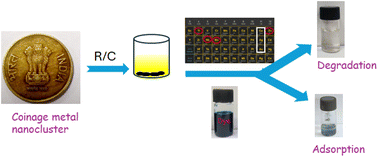
RSC Adv., 2024,14, 11411-11428
https://doi.org/10.1039/D4RA00931B
Cyanoremediation of heavy metals (As(V), Cd(II), Cr(VI), Pb(II)) by live cyanobacteria (Anabaena variabilis, and Synechocystis sp.): an eco-sustainable technology
Cyanoremediation of heavy metals by surface adsorption of live cyanobacteria represents a promising technique for wastewater treatment.

RSC Adv., 2024,14, 10452-10463
https://doi.org/10.1039/D4RA00409D
CoAl-LDH decorated with cerium oxide as an efficient adsorbent for restoring low-concentration phosphate in wastewater
The requirement for the removal of phosphorus (P) from wastewater has become progressively stringent, therefore, it is essential to remove low-concentration phosphate from secondary effluents through a tertiary treatment.
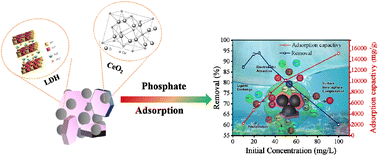
RSC Adv., 2024,14, 10056-10069
https://doi.org/10.1039/D3RA08201F
Recent advances in microbial and enzymatic engineering for the biodegradation of micro- and nanoplastics
This review examines the escalating issue of plastic pollution, specifically highlighting the detrimental effects on the environment and human health caused by microplastics and nanoplastics.

RSC Adv., 2024,14, 9943-9966
https://doi.org/10.1039/D4RA00844H
Design and application of metal organic frameworks for heavy metals adsorption in water: a review
The growing apprehension surrounding heavy metal pollution in both environmental and industrial contexts has spurred extensive research into adsorption materials aimed at efficient remediation.
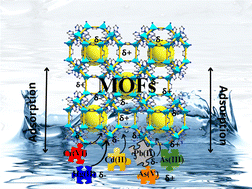
RSC Adv., 2024,14, 9365-9390
https://doi.org/10.1039/D3RA08815D
Development of electrochemical sensors for quick detection of environmental (soil and water) NPK ions
When a plant shows deficiency syndromes, sometimes it becomes too late for the farmer to apply fertilizer, as most rely on checking plant leaves to assess their nutrition level. Electrochemical sensors can bring revolution here. Other pollutants (NPK) can also be determined using these sensors.

RSC Adv., 2024,14, 9137-9158
https://doi.org/10.1039/D4RA00034J
Fabrication of zinc oxide nanorods for photocatalytic degradation of docosane, a petroleum pollutant, under solar light simulator
Advanced oxidation processes (AOP) play a vital role in photocatalytic treatment of hazardous chemicals in oil-produced water (OPW).

RSC Adv., 2024,14, 9038-9049
https://doi.org/10.1039/D4RA00672K
Photocatalytic degradation of drugs and dyes using a maching learning approach
The waste management industry uses an increasing number of mathematical prediction models to accurately forecast the behavior of organic pollutants during catalytic degradation.

RSC Adv., 2024,14, 9003-9019
https://doi.org/10.1039/D4RA00711E
Bioaccumulation and in vivo tracking of radiolabeled 4-nonylphenol in mice
4-Nonylphenol, an emerging endocrine disruptor, raises health concerns. Radiolabeling and in vivo tracing of 4NP reveal significant tissue accumulation, emphasizing intricate distribution and potential long-term effects for risk assessments.

RSC Adv., 2024,14, 8578-8582
https://doi.org/10.1039/D3RA08743C
Effective extraction and determination of 24 quinolones in water and egg samples using a novel magnetic covalent organic framework combined with UPLC-MS/MS
We designed and fabricated a novel functionalized magnetic covalent organic framework as a magnetic solid-phase extraction (MSPE) absorbent for the determination of 24 quinolones.

RSC Adv., 2024,14, 8303-8312
https://doi.org/10.1039/D4RA00247D
Browse by Subject
- All (336 articles)
- Atomic/elemental (14 articles)
- Bioanalytical (65 articles)
- Chemometrics (30 articles)
- Crystallography (164 articles)
- Electroanalytical (57 articles)
- Imaging/microscopy (32 articles)
- Mass spectrometry (22 articles)
- Medical diagnostics (77 articles)
- Microfluidics (17 articles)
- Nanoanalysis (20 articles)
- Separation science (27 articles)
- Spectroscopy (95 articles)
- All (272 articles)
- Bioinorganic chemistry (49 articles)
- Bioorganic chemistry (27 articles)
- Biotechnology (51 articles)
- Cellular chemistry (56 articles)
- Computational (84 articles)
- Drug delivery (78 articles)
- Drug discovery (181 articles)
- Imaging/diagnostics (15 articles)
- Molecular biology (6 articles)
- Nanotechnology (44 articles)
- Natural products (30 articles)
- Pharmacology (85 articles)
- Photobiology (15 articles)
- Polymorphism (pharma) (1 article)
- Structural biology (12 articles)
- Toxicology (3 articles)
- All (555 articles)
- Biomaterials (101 articles)
- Biopolymers (99 articles)
- Carbon materials (100 articles)
- Composites (247 articles)
- Electronic materials (96 articles)
- Encapsulation (1 article)
- Energy applications (84 articles)
- Films/membranes (82 articles)
- Gels & soft matter (36 articles)
- Inorganic materials (48 articles)
- Medical materials (66 articles)
- Nanomaterials (125 articles)
- Optical materials (51 articles)
- Organic materials (55 articles)
- Polymers (133 articles)
- All (349 articles)
- Assembly (11 articles)
- Biotechnology (30 articles)
- Carbon nanomaterials (80 articles)
- Imaging/microscopy (17 articles)
- Nanoanalysis (42 articles)
- Nanocatalysis (31 articles)
- Nanomaterials (217 articles)
- Nanomedicine (43 articles)
- Nanotoxicology (55 articles)
- Optical nanomaterials (33 articles)
- Synthesis (12 articles)
- All (173 articles)
- Bioorganic (17 articles)
- Catalysis (46 articles)
- Fine chemicals (26 articles)
- Natural products (23 articles)
- Physical organic (8 articles)
- Stereochemistry (11 articles)
- Supramolecular (3 articles)
- Sustainable synthesis (35 articles)
- Synthetic methodology (100 articles)
- Total synthesis (13 articles)
- All (320 articles)
- Biophysics (2 articles)
- Charge transfer (28 articles)
- Electrochemistry (13 articles)
- Energy research (18 articles)
- Imaging/microscopy (5 articles)
- Kinetics & dynamics (40 articles)
- Materials (104 articles)
- Mechanics (34 articles)
- Nanoscience (69 articles)
- Photoscience (26 articles)
- Quantum & theoretical (90 articles)
- Simulations (23 articles)
- Single molecules (40 articles)
- Soft matter (5 articles)
- Spectroscopy (7 articles)
- Surfaces & interfaces (71 articles)